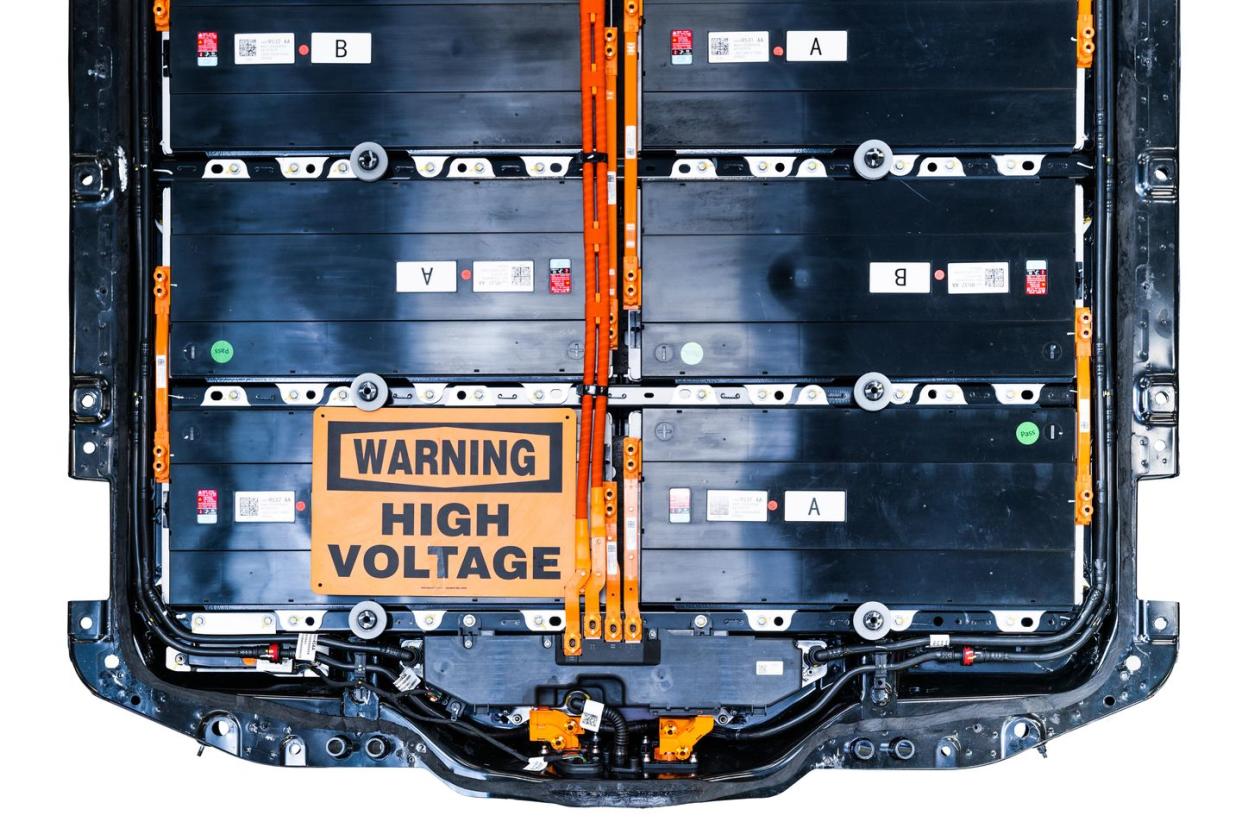Building Better Batteries for Electric Vehicles

From the July/August 2023 issue of Car and Driver.
In 2011, a Nissan Leaf carried a roughly 21.0-kWh battery that gave it an EPA range of 73 miles. The 2023 Leaf battery offers nearly three times the capacity and range in a pack with just slightly bigger dimensions.
Designing an EV with greater range doesn't always mean a bigger, heavier battery, despite efforts like the 170.0-kWh pack in the 8660-pound GMC Hummer EV SUV (pictured above).
Here are the factors battery engineers consider and the trade-offs vehicle teams must grapple with.
Cell Chemistry
The most fundamental decision in designing an EV battery is what specific chemistry to use. Battery engineers must balance energy capacity, power delivery, cost, and volatility. In many cases, a cell supplier and an automaker jointly develop vehicle-specific applications, such as Tesla and Panasonic or GM and LG Energy Solution.
In the U.S., many EVs use lithium-ion cells containing some mix of nickel, manganese, cobalt, and aluminum with their lithium. These are known as NMCA cells.
In China, the prevailing chemistry is lithium-iron-phosphate, or LFP. It costs less, uses fewer hard-to-source minerals, and is often safer under extreme conditions, but the technology holds less energy in a given volume. Tesla has begun using LFP for some U.S. models, and Ford announced it will build an LFP cell plant for its electric vehicles.
Cell Format
Battery engineers must decide what shape (known as "format") each cell should be—though, in practice, not every supplier offers every cell chemistry in every format. Tesla pioneered the use of thousands of small-format cylindrical cells (similar to AA batteries) in a battery pack; many other makers have opted for hundreds of larger cells in pouch or prismatic formats, which are two versions of rectangular shapes. Multiple cells are grouped into modules that are placed into a large rectangular container to make up the pack. Some batteries have eight modules, while others have dozens. Cells within modules are wired in series, and modules are wired in parallel.

The new GMC Hummer pickups and SUVs have two 400-volt module groups in parallel that switch to an 800-volt series to allow DC fast-charging of up to 300 kilowatts.
Cell and Pack Dimensions
While there are standard sizes for cylindrical cells, some of the other cell formats are made in sizes specific to a given automaker. The challenge engineers face is packing the maximum energy into a battery pack with the smallest possible dimensions while ensuring there's sufficient room for liquid-cooling channels, all the wiring that connects cells within modules and modules to each other, and proper separation of modules for safety.
Today, virtually any EV with a range of 200 miles or more has a battery under the cabin floor that stretches from door to door, axle to axle. Often there's also a raised hump under the rear seat for more capacity, and sometimes what the Germans call “foot garages” are recessed into the pack to allow sufficient rear-seat legroom in lower vehicles. These heavy underfloor packs do have the benefit of lowering the center of gravity, thus improving vehicle stability and handling.
Capacity (i.e., Range)
Finally, battery engineers, vehicle product managers, and their accountants will debate what battery capacities to offer. The goal is an EV they can sell at the right price with sufficient range to reassure customers that it's a practical option for their lives and travels. We've found that in the U.S., around 250 miles seems to be the minimum range to get people to consider trading internal combustion for electric motors for daily use. GM has said it thinks 300 miles is the benchmark at which buyers stop worrying about range. There are few EVs that can actually deliver on the EPA range posted on their window-sticker label, however.
Even so, during the past decade of EV development, this is the area where the most progress has been made. In 2013, the state of the art was a Nissan Leaf with 75 miles of EPA range at a price around $30,000 or a Tesla Model S with 265 miles at over $90K. The options have an even wider spread today. You can buy the dead-man-walking Chevrolet Bolt EV, with 258 miles of range, for $27,495; one model of the Lucid Air luxury sedan is rated at more than 500 miles and comes with a six-figure price tag.
But simply upping the battery capacity has a diminishing return. A bigger, heavier pack is inherently less efficient, so automakers must parley good battery tech with other efficiencies to remain competitive.
You Might Also Like
